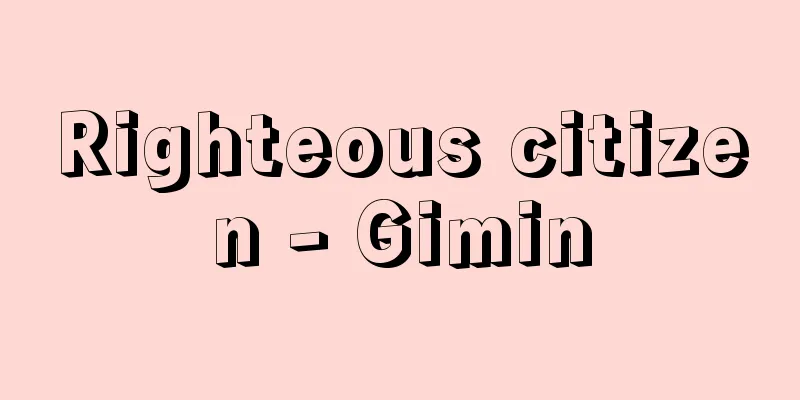Righteous citizen - Gimin

|
A person who sacrificed himself for the justice and happiness of the common people. This applies particularly to the Edo period. The term is used broadly to refer to those who risked their lives to remove disasters from the common people and sacrificed themselves to do so, but the term is often used to refer to those who led uprisings against the lawlessness of feudal lords and were executed. Gimin was established based on the idea of deities (hitogami shinkou) that dead people are worshipped as gods. Because their deaths are characterized as untimely deaths that are necessary for the survival of the community, the worshipped deities are often considered to be cursed deities by the members of the community. For this reason, although there are various types of deities, such as Myojin and Jizo-son, the nature of the faith is generally that of a goryo faith that worships cursed deities. Therefore, faith in the worship of Gimin (Gimin shinkou) was established as a requirement that descendants (communities) continue to hold memorial services for the deceased and as a demand that the illegal acts of the feudal lord that caused the untimely death not be committed again, and it is considered that if these are broken, the deity will bring a curse. In this way, Gimin shinkou was established as a way to make people remember the uprisings and to prevent the arbitrary actions of the feudal lord. However, unlike these cases, some Gimin became agricultural deities (Nojin). In this case, the god is remembered by people through their yearly productive labor as a god that brings about fertility. There are also righteous people who are said to have miraculous powers for treating certain illnesses. The popular resistance movements that gave birth to the above-mentioned Gimin often took the form of representative petitions or peasant petitions. This is because these ikki often represented the overall interests of the community, and they rarely emerged from movements triggered by internal conflicts within the community, such as the Sekai-i-kki and Murakata-so uprisings of the late Edo period. Among the Gimin, those who actually had a great influence were the Gimin of the early Edo period, such as Sakura Sogoro (Sougo), Matsuki Choso, and Haritsuke Mozaemon, who emerged from representative petition-type ikki. In the case of these Gimin, all the elements that make up a Gimin were included, such as the thoroughly misruled government of the feudal lord, noble acts of sacrifice, heroic execution, and achievement of a goal, but the original incident (ikki) itself is often ambiguous. However, the image of the righteous min (Gimin) gradually grew in size and became famous as a Gimin legend, and sometimes helped the establishment of uprisings in the middle and later periods. For example, Sakura Sogoro became popular as a Gimin legend from the mid-18th century onwards, and was included in one of the themes of Kabuki at the end of the Edo period, becoming popular, and Sogo Daimyojin was enshrined in the Ina Minamiyama Uprising, and Sogo's storytelling was used to recruit peasants. It is the people who create righteous people, but they are not the only ones who commemorate them. In fact, it is not permissible for the people to publicly worship or hold memorial services for the leaders of prohibited cliques, and so when the people commemorate them, they make ingeniously designed gravestones and monuments to righteous people so as not to be noticed, and hold commemoration ceremonies in secret. On the other hand, there were also cases where feudal lords commemorated them to appease their subjects, or where village officials commemorated them to meet the wishes of small farmers. From the Meiji period to the present day, there have been two trends that have continued: one that commemorates righteous people for the expansion of people's rights, and one that commemorates them for the unification of the region. [Katsumi Fukaya] "Yokoyama Jūshio's 'Gimin' (Sanseido Shinsho)" ▽ "Yokoyama Jūshio's 'Peasant Revolts and the Legend of Gimin' (Kyōikusha Rekishi Shinsho)" ▽ "Kodama Kōta's 'Sakura Sogoro' (1958, Yoshikawa Kobunkan)" Source: Shogakukan Encyclopedia Nipponica About Encyclopedia Nipponica Information | Legend |
|
民衆社会の正義と幸福のために一身を犠牲にした者。とくに江戸時代についていう。民衆社会に降りかかる厄災を除くために一身を挺(てい)し、そのために犠牲になった者を広くさすが、とくに領主の非法に抵抗して一揆(いっき)を指導し刑死した者を義民(義人)とよぶことが多い。 義民は、死んだ人間を神として祀(まつ)るという神観念(人神信仰)を一つの要素にして成立する。その死が、共同体の存続のための非業(ひごう)の死という性格をもつため、祀られた神は共同体の者にとっては祟(たた)る神と観念されることが多い。そのため、神格としては、明神(みょうじん)や地蔵尊(じぞうそん)など、さまざまなものがあるものの信仰の性格はおおむね祟る神を祀るものとしての御霊(ごりょう)信仰となる。したがって、義民を祀る信仰(義民信仰)は子孫(共同体)が供養し続けることを義務づけ、非業の死の因となった領主の非法が二度と行われぬことを要求するものとして成立し、それらが破られれば祟ると観念される。こうして義民信仰は人々の間に一揆を記憶させ、領主の恣意(しい)を阻止するものとして成立する。しかし、義民のなかにはこれらの場合とは違って、農業神(農神)になるものもあった。この場合は豊穣(ほうじょう)の効果をもたらすものとして年々の生産労働のなかで人々に記憶されていく。ほかに、特定の病気に霊験(れいげん)ありとされる義民もある。 前記のような義民を生み出す民衆の抵抗運動は、代表越訴(おっそ)や惣百姓強訴(そうびゃくしょうごうそ)の形態をとる一揆が多い。それはこの一揆が共同体の全体的な利益を代表することが多いからで、幕末の世直し一揆や村方騒動のように共同体の内部の対立を契機にする運動からは出にくい。義民のなかで実際に大きな影響力をもったものは江戸初期の義民で、代表越訴型の一揆から出てくる佐倉惣五郎(さくらそうごろう)(宗吾)や松木長操(ちょうそう)、磔茂左衛門(はりつけもざえもん)らがある。これらの義民の場合には、徹底した領主の悪政、崇高な犠牲的行動、壮烈な刑死、目的の達成など義民を構成する要素がすべて含まれるが、もともとの事件(一揆)自体はあいまいな点が多い。しかし、義民像としては義民伝承としてしだいに肥大化して有名になり、中後期の一揆の成立を助けることがあった。たとえば佐倉惣五郎は18世紀中葉以降、義民伝承として流布し、幕末には歌舞伎(かぶき)の演題の一つに仕組まれて人気を博し、伊那南山(いなみなみやま)一揆では宗吾(そうご)大明神が勧請(かんじょう)され、宗吾講談で農民が勧誘されたりもした。 義民を創造するのは民衆であるが、義民を顕彰するのは民衆だけではない。むしろ民衆が禁制の徒党の指導者を大々的に祀ったり供養することは本来許されぬことで、そのため、民衆が顕彰する場合には気づかれぬよう巧妙にくふうした墓碑、義民碑がつくられ、ひそかに顕彰行事が行われたりする。他方、領主が領民を慰撫(いぶ)するために顕彰したり、村役人が小前(こまえ)百姓の意を迎えるために顕彰することもあった。明治以降も現在に至るまで、民衆の権利の伸長のために義民を祀る立場と、地域の統合のために祀る立場の二つの流れが続いている。 [深谷克己] 『横山十四男著『義民』(三省堂新書)』▽『横山十四男著『百姓一揆と義民伝承』(教育社歴史新書)』▽『児玉幸多著『佐倉惣五郎』(1958・吉川弘文館)』 出典 小学館 日本大百科全書(ニッポニカ)日本大百科全書(ニッポニカ)について 情報 | 凡例 |
>>: Pseudo‐alum (English spelling)
Recommend
Usami [Hot Spring] - Usami
...There are many cases where hot springs stop fl...
Pratyekabuddha
The Buddhist term is used to refer to the state in...
rhythmic sedimentation
…Good examples include varved clay, graded beddin...
X-Ray Star - X-Sensei
A common name for star-like X-ray sources in the M...
Tomb of Wang Guang - Wang Guang-myo
A tomb located in Jeongbaek-dong, Lelang District,...
Kiyoyoshi Shrine
…Ryukoji Temple, the 41st temple of the 88 Shikok...
Ninomiya [town] - Ninomiya
A former town in Haga County in southern Tochigi P...
Standard wage - kijunnaichigin
Wages paid for work performed under standard work...
Sānī (English spelling)
…Official name = Dawla al-Qaṭar∥State of QatarAre...
Pacifier sucking
The opinion of the Health Review Committee of Pedi...
Aya - Aya
…corresponds to the Sumerian Utu. Son of Sin and ...
VALS - Value and Lifestyle
Stanford Research Institute's lifestyle analys...
Yukiyoshi Aoyama
1855 * -1930 Daimyo and aristocrats from the end ...
Different shelf - Different
A shelf made of two staggered boards built into th...
she-tamana (English spelling)
...The "momo" in Momotamana means peach...


![Suwon [town] - Suibara](/upload/images/67cbf16f8c798.webp)




![Kohoku [town] - Kohoku](/upload/images/67cb8c421d5b8.webp)

